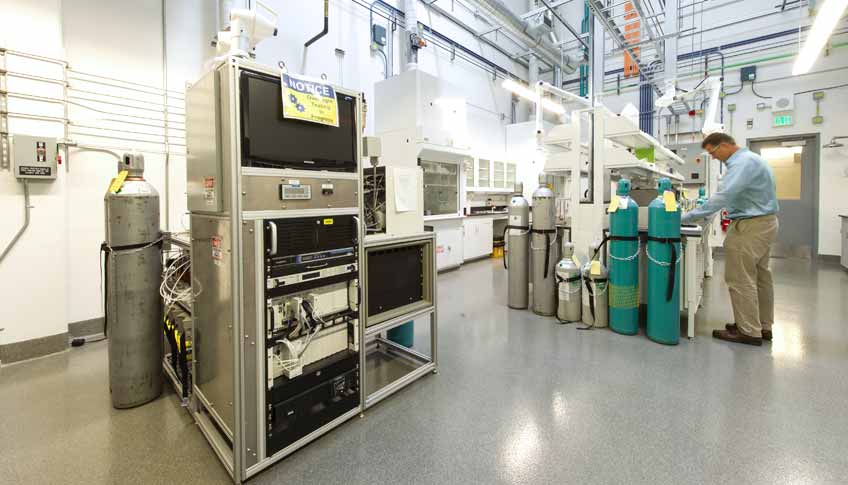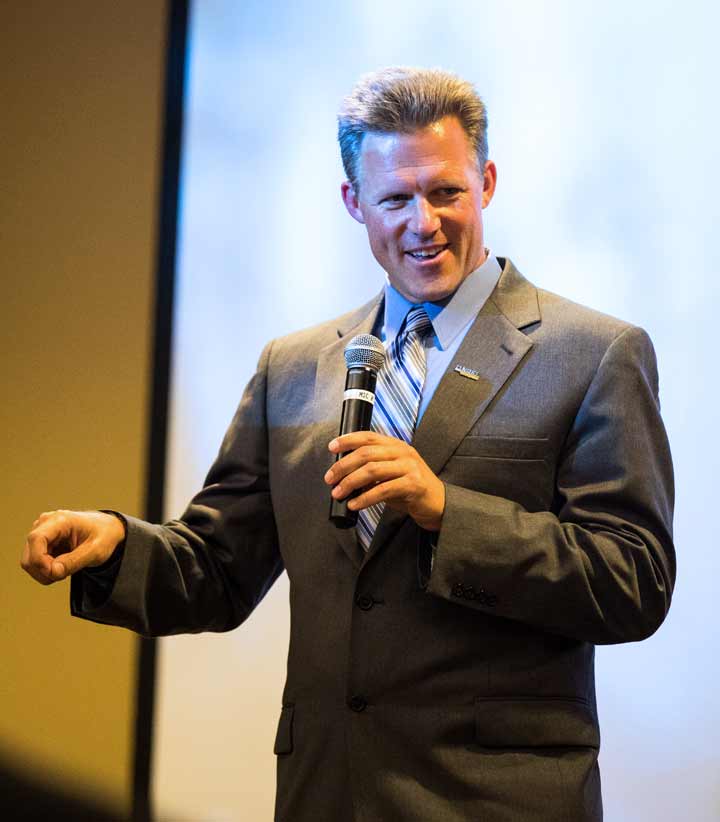Bryan Pivovar: Champion for H2@Scale
Senior Fellow Advocates for Hydrogen as a Clean Energy Alternative

In this 2013 photo, Bryan Pivovar works on a sensor test apparatus for testing hydrogen safety sensors in NREL's Energy Systems Integration Facility. Photo by Dennis Schroeder / NREL
“I never thought those skills would be particularly important in science,” said Pivovar, “but much of my recent success professionally may have more to do with marketing than it does with science.”
Not that his science is lacking, but the newly appointed senior research fellow at the U.S. Department of Energy's (DOE's) National Renewable Energy Laboratory (NREL) believes his marketing ability helped him clarify and sell the benefits of hydrogen. Others agree.
“He is a tireless advocate of integrating hydrogen in the entire energy system,” said Jao van de Lagemaat, director of NREL’s Chemistry and Nanoscience Center.
So, it was natural that Sunita Satyapal, director of DOE’s Fuel Cell Technologies Office, in Pivovar’s words, “voluntold” him to lead a “big idea” focusing on hydrogen across the national laboratory system. He reluctantly agreed.
“I knew it was important that NREL take the lead in this area, but it wasn’t until we were a few months into putting the story together that I began to realize how much benefit hydrogen has to offer,” he said.
He also learned how low the marginal costs of implementing hydrogen could be with the proper research and infrastructure investments. “Now I see it as the most important professional effort of my career.”
The initiative, which began in 2015, took major steps forward in 2016 as several dozen staff members from across 14 DOE national laboratories worked together to evaluate the potential of hydrogen across the U.S. energy system. The group also engaged industry, regulatory bodies, utilities, and other stakeholders.
This effort became known as H2@Scale (hydrogen at scale). It has continued to grow, resulting in DOE’s current H2@Scale initiative. Along the way, DOE has given two Fuel Cell Technologies Office recognition awards (in 2016 and 2018) for Pivovar and other national laboratory contributors, citing analysis and scoping of the initial vision.
The H2@Scale goal is to use the unique attributes of hydrogen to address critical challenges currently facing our energy system, Pivovar said. Notably, hydrogen can be made efficiently and intermittently from low-cost (renewable) electricity, while enabling clean, efficient end use (grid, transportation, buildings, and industry).
Additionally, hydrogen allows for grid-scale energy to be shifted across time, distance, and energy sectors, empowering society to service all its needs cleanly, efficiently, reliably, and economically.
“Hydrogen and renewable energy have the ability to leverage each other, allowing each to make the other more economically viable and competitive,” he said.
In Pivovar’s opinion, this is one of the main factors that makes NREL such an exciting place to do hydrogen research.
“What I’ve seen in the last few years is incredible,” Pivovar said. “The ways industry and investors are embracing hydrogen are making it seem that, as much as the past decade has been the decade of wind and solar, the 2020’s are looking to be the decade of hydrogen.”
An Early Fuel Cell Researcher
Today, people may be generally familiar with the concept of hydrogen fuel cells: devices that convert chemical potential energy (energy stored in molecular bonds) into electrical energy. The technology is becoming more marketable. California began selling hydrogen fuel in 2015 and has more than 40 hydrogen fueling stations for more than 7,000 fuel cell cars so far. Major automakers have announced production expansions into the several tens of thousands of fuel cell vehicles in the next few years.
But when Pivovar began his doctoral research in 1994 at the University of Minnesota, fuel-cell technology was largely unknown—even by him. “When I started my Ph.D., I wanted to work on either catalysts or polymers,” tracks that could have led to working with companies such as ExxonMobil. “And that would be great,” he said. “I didn’t expect to be a renewable energy scientist.”
However, an unexpected twist led him in a different direction.
A thesis advisor alerted him to the fact that there was going to be funding for fuel-cell research starting the following year, a topic that needed both catalyst and polymer research. Pivovar, who had a fellowship for his first year of graduate school, got a one-year head start on the project because he had independent funding in hand. The adviser sagely told him, “You can have first choice of what direction you want to go.”
“At the time, fuel cells were a giant white space,” he said, and because his advisers weren’t established fuel cell experts, “we were all learning together.” In reality, he said, this meant that “I got to do fuel cell work before anybody else knew what fuel cells were.”
In part, he was often more educated in the area than his advisers, because he could dedicate 100% of his time to learning about the topic from the literature. As a result, the junior students would often come to him for advice. “While it extended my time in graduate school, it served as great training and almost certainly accelerated my career,” he said.
Still, the technology was largely unheralded. “When I got my Ph.D. in fuel cells in 2000, I always had to explain to people what a fuel cell was,” he said. “That isn’t the case anymore.”

NREL as a Launching Pad for Hydrogen
Prior to joining NREL, Pivovar had worked his way up from a postdoctoral researcher to a staff member, eventually becoming fuel cell team leader at Los Alamos National Laboratory. The fuel cell research program at Los Alamos was the largest and best established in the DOE laboratory system, whereas NREL’s fuel cell research budget was almost nonexistent at the time.
But he ultimately decided to come to NREL. Such a move came with significant risk, but, in Pivovar’s words, “NREL was a better fit for renewable energy research compared to a weapons lab.” That decision has worked out better than he ever could have expected.
At NREL, Pivovar has filled multiple roles from researcher/principal investigator to group manager to acting center director. In these roles, he has led the establishment of world class electrochemical research capabilities.
These capabilities start with team members, he said. Some—such as Mike Ulsh and Huyen Dinh, who oversee major efforts including manufacturing and water splitting materials, respectively—were pioneering just before Pivovar’s arrival at NREL. Others—including Guido Bender, KC Neyerlin, and Shaun Alia—predate the team’s move into NREL’s Energy Systems Integration Facility (ESIF) and have been critical leaders in the establishment and growth of NREL’s activities in this area.
“Bryan is an excellent scientist with exceptional leadership and interpersonal qualities,” said Dinh, who serves as senior scientist and hydrogen production lead at NREL. “He has big ideas and the interpersonal skills to convince people that what he does is important and should be funded. He cares about people and genuinely wants to help people succeed.”
While Pivovar would argue that the people are more important than the equipment and facilities, he also recognizes how special their ESIF labs are. He said that NREL is unique in the breadth of areas it covers, what his group refers to as “Powders to Power.” The team’s research reaches from catalyst and polymer synthesis to electrode and device fabrication. It also covers manufacturing and advanced cell diagnostics.
“Materials synthesis is something that happens at every university in the world,” Pivovar said. “While it does help to have that capability in house, we focus on fabricating electrodes and performing advanced diagnostics to improve cost, performance, and durability to separate our research from that of other institutions.” As a result, he said, “our team, capabilities, and collaborators are recognized internationally as state of the art.”
He has a clear vision: “My goal is for NREL to be known as ‘Electrodes ‘R’ Us,’” he said.
Getting Settled into ESIF
While the team originally moved into the ESIF in 2013, it took several years for the labs and staff to get fully established there. The basis of initial emphasis was fuel cell research, but the team in recent years has been expanding in people and scope to include electrolysis and electrochemical reduction of carbon dioxide, both key areas for NREL’s electrons-to-molecules research.
Pivovar's work spans much of the fuel cell and electrolysis space, including membranes, catalysts, and/or membrane electrode assemblies. Alkaline membranes have become a stronger focus, as their performance and durability has increased considerably in recent years.
Pivovar has been a recognized leader in the field since he had the first DOE-funded project in the area in 2005. He has also overseen extended surface catalyst development, as well as emerging research into decreasing the cost of low-temperature electrolysis.
Beyond the ability to focus on materials research, another significant advantage of being at NREL is the opportunity to interact with a range of other research groups. Those include large-scale electrolysis systems, infrastructure researchers, systems/techno-economic analysts, and others across the renewable energy research spectrum.
“These interactions are only possible at NREL and have played a major role in accelerating the energy system fit of hydrogen,” he said. “I couldn’t have as effectively led H2@Scale development anywhere else, as I wouldn’t have understood the challenges facing solar and wind and wouldn’t have had access to the analysts with the knowledge and skills to run different case studies.”
All the complexity boils down to a basic equation, he said. “NREL has been a perfect fit for me, and I’d like to think I’m a good fit for NREL.”
The Future of Hydrogen

When it comes to his selection to lead the effort that became H2@Scale, Pivovar “credits” his outspoken thoughts when trying to convince DOE’s Fuel Cell Technologies Office to focus on hydrogen beyond transportation and as a mechanism to economically enable wind and solar penetration.
“In my opinion, Bryan is among the foremost electrochemists in the world,” said Keith Wipke, NREL's laboratory program manager for fuel cells and hydrogen technologies. “His efforts as our fuel cell and electrolysis materials research lead have ensured that NREL’s program is cutting edge. Because of his contributions, we’re well-positioned to continue to innovate.”
While there are several recent studies and road maps that lay out pathways and examine the long-term economic viability of hydrogen at scale, there remain significant challenges based on cost, performance, durability, market acceptance, regulation, and policy.
“These will be areas where NREL can continue helping lead the way with the engagement of other stakeholders,” he said.
While hydrogen safety is a concern, every energy carrier has hazards associated with it, and Pivovar said hydrogen is not that much more difficult to handle, store, or move than natural gas. “It’s just more expensive to do so,” he added.
That’s because hydrogen doesn’t have the established infrastructure for distribution and is not native to the ground like natural gas. At the global (gigaton) scale, hydrogen storage costs have to be exceptionally low. “Salt caverns are great for this,” he said.
The biggest barrier is the cost of building an infrastructure, but Pivovar is optimistic about progress in the next five years, especially because of the support of industry-led groups such as the Hydrogen Council, which includes many members of the oil and gas industry.
One ingredient is key: “You need to be able to envision a future that doesn’t exist today,” he said.
Pivovar said that the support of those around him—in research, analysis, and management—are helping him refine and spread the message. Now that he’s an NREL senior fellow, his pronouncements will carry greater weight.
Through it all, it comes to back to making his case for hydrogen. That draws on a lifelong skill.
“The ability to convey information clearly and succinctly has a lot of value,” he said. “Having the technical depth behind it is useful, of course.” But for him, the equation is simple: “How do you make your viewpoint clear and sell it?”
Pivovar knows. It’s what he does daily.
That’s why he believes, despite challenges, the future is wide open for hydrogen deployment. “We need to provide energy services—and it comes down to the best way to provide them,” he said.
Pivovar credited NREL and its researchers with having much to do with “making renewable energy electrons among the cheapest electrons on the planet.” Now, by advocating for hydrogen technologies, “Mr. Hydrogen @ Scale” (as his colleagues nicknamed him) said that he sees the next target.
“We can help reform the entire system, not just the grid,” he said.
That’s not too tall an order for a guy from the Badger State who has been successfully marketing since he was a teenager.
Last Updated May 28, 2025
